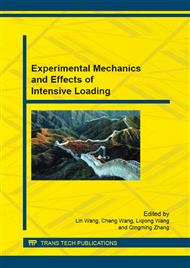p.137
p.143
p.153
p.158
p.164
p.170
p.177
p.183
p.197
Research of the Anti-Penetration Mechanism for Titanium Alloys Armor Based on 3D Optical Scanning Technology
Abstract:
To reveal the anti-penetration mechanism of titanium alloys armor quantitively, the volumes of the front crater region, the ductile hole-enlargement region, as well as the back caving region of Ti-6Al-4V alloy and β20C alloy were measured via 3D Optical scanning technology. The experimental results show that β20C alloy, of which the volume fraction of ductile hole-enlargement region is 51%, 10% larger than that of Ti-6Al-4V alloy, presents a better ballistic performance. It is found that the ballistic performance is closely related to the volume of ductile hole-enlargement region and a relatively larger ductile hole is beneficial to improve the ballistic performance. However, the ballistic performance shows no improvement with increasing the volume of front crater region.
Info:
Periodical:
Pages:
164-169
Citation:
Online since:
August 2015
Authors:
Price:
Сopyright:
© 2015 Trans Tech Publications Ltd. All Rights Reserved
Share:
Citation:


